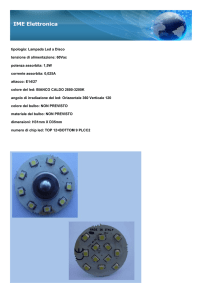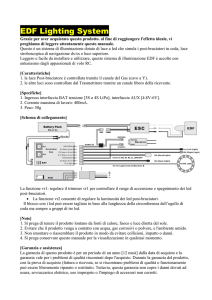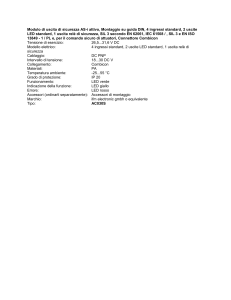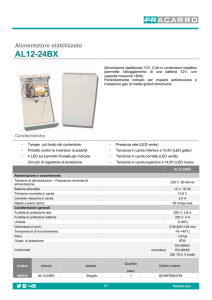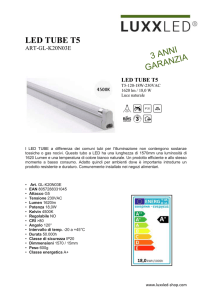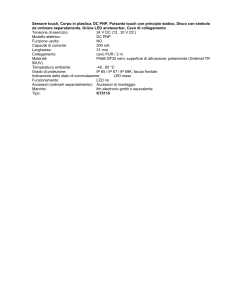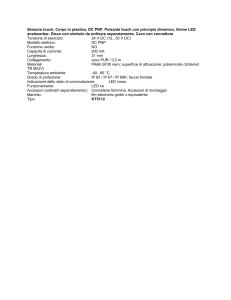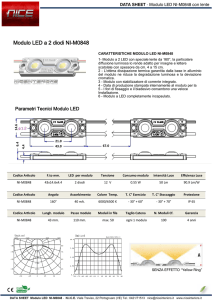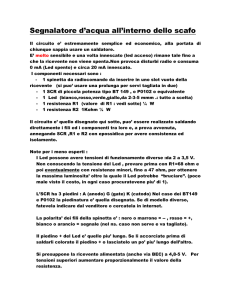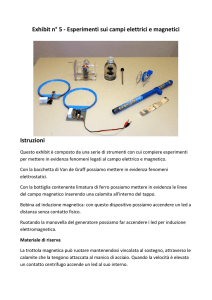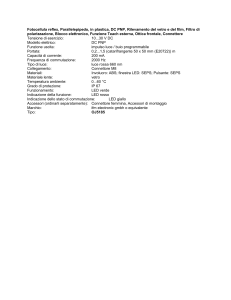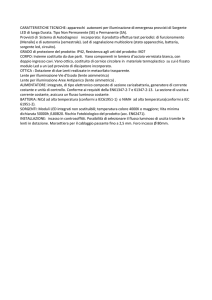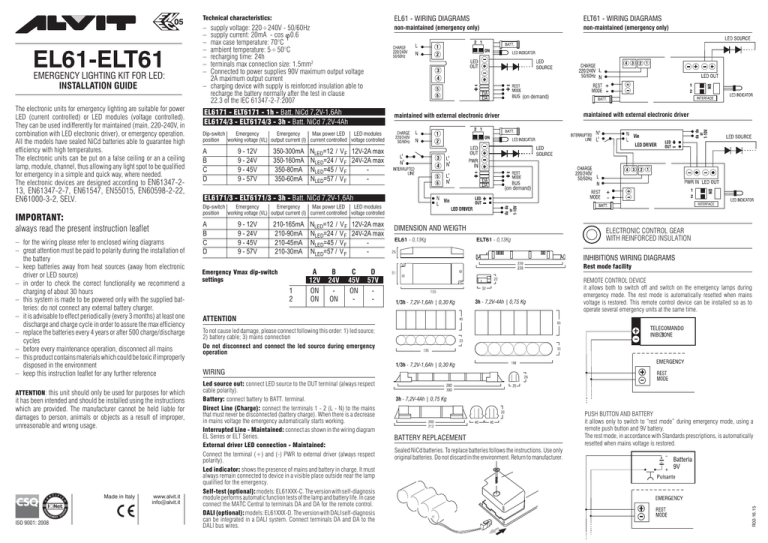
EMERGENCY LIGHTING KIT FOR LED:
INSTALLATION GUIDE
The electronic units for emergency lighting are suitable for power
LED (current controlled) or LED modules (voltage controlled).
They can be used indifferently for maintained (main, 220-240V, in
combination with LED electronic driver), or emergency operation.
All the models have sealed NiCd batteries able to guarantee high
efficiency with high temperatures.
The electronic units can be put on a false ceiling or an a ceiling
lamp, module, channel, thus allowing any light spot to be qualified
for emergency in a simple and quick way, where needed.
The electronic devices are designed according to EN61347-2-
13, EN61347-2-7, EN61547, EN55015, EN60598-2-22,
EN61000-3-2, SELV.
IMPORTANT:
always read the present instruction leaflet
– for the wiring please refer to enclosed wiring diagrams
– great attention must be paid to polarity during the installation of
the battery
– keep batteries away from heat sources (away from electronic
driver or LED source)
– in order to check the correct functionality we recommend a
charging of about 30 hours
– this system is made to be powered only with the supplied batteries: do not connect any external battery charger.
– it is advisable to effect periodically (every 3 months) at least one
discharge and charge cycle in order to assure the max efficiency
– replace the batteries every 4 years or after 500 charge/discharge
cycles
– before every maintenance operation, disconnect all mains
– this product contains materials which could be toxic if improperly
disposed in the environment
– keep this instruction leaflet for any further reference
ATTENTION: this unit should only be used for purposes for which
it has been intended and should be installed using the instructions
which are provided. The manufacturer cannot be held liable for
damages to person, animals or objects as a result of improper,
unreasonable and wrong usage.
Made in Italy
ISO 9001: 2008
www.alvit.it
[email protected]
EL61 - WIRING DIAGRAMS
ELT61 - WIRING DIAGRAMS
–
–
–
–
–
–
–
non-maintained (emergency only)
non-maintained (emergency only)
supply voltage: 220÷240V - 50/60Hz
supply current: 20mA - cos 0.6
max case temperature: 70°C
ambient temperature: 5÷50°C
recharging time: 24h
terminals max connection size: 1.5mm2
Connected to power supplies 90V maximum output voltage
2A maximum output current
– charging device with supply is reinforced insulation able to
recharge the battery normally after the test in clause
22.3 of the IEC 61347-2-7:2007
(on demand)
EL6171 - ELT6171 - 1h - Batt. NiCd 7,2V-1,6Ah
EL6174/3 - ELT6174/3 - 3h - Batt. NiCd 7,2V-4Ah
maintained with external electronic driver
maintained with external electronic driver
Dip-switch
Emergency
Emergency
Max power LED
LED modules
working voltage (VL) output current (I) current controlled voltage controlled
position
A
B
C
D
9 - 12V
9 - 24V
9 - 45V
9 - 57V
350-300mA
350-160mA
350-80mA
350-60mA
NLED=12 / V F 12V-2A max
NLED=24 / V F 24V-2A max
NLED=45 / V F
NLED=57 / V F
(on demand)
EL6171/3 - ELT6171/3 - 3h - Batt. NiCd 7,2V-1,6Ah
Dip-switch
Emergency
Emergency
Max power LED
LED modules
working voltage (VL) output current (I) current controlled voltage controlled
position
A
B
C
D
9 - 12V
9 - 24V
9 - 45V
9 - 57V
210-165mA
210-90mA
210-45mA
210-30mA
Emergency Vmax dip-switch
settings
1
2
NLED=12 / V F 12V-2A max
NLED=24 / V F 24V-2A max
NLED=45 / V F
NLED=57 / V F
A
12V
ON
ON
B
24V
ON
C
45V
ON
-
D
57V
-
DIMENSION AND WEIGTH
EL61 - 0,13Kg
ELT61 - 0,13Kg
26
ELECTRONIC CONTROL GEAR
WITH REINFORCED INSULATION
INHIBITIONS WIRING DIAGRAMS
Rest mode facility
51
155
1/3h - 7,2V-1,6Ah | 0,30 Kg
3h - 7,2V-4Ah | 0,75 Kg
REMOTE CONTROL DEVICE
it allows both to switch off and switch on the emergency lamps during
emergency mode. The rest mode is automatically resetted when mains
voltage is restored. This remote control device can be installed so as to
operate several emergency units at the same time.
ATTENTION
To not cause led damage, please connect following this order: 1) led source;
2) battery cable; 3) mains connection
Do not disconnect and connect the led source during emergency
operation
WIRING
Led source out: connect LED source to the OUT terminal (always respect
cable polarity).
Battery: connect battery to BATT. terminal.
Direct Line (Charge): connect the terminals 1 - 2 (L - N) to the mains
that must never be disconnected (battery charge). When there is a decrease
in mains voltage the emergency automatically starts working.
Interrupted Line - Maintained: connect as shown in the wiring diagram
EL Series or ELT Series.
External driver LED connection - Maintained:
Connect the terminal (+) and (-) PWR to external driver (always respect
polarity).
Led indicator: shows the presence of mains and battery in charge. It must
always remain connected to device in a visible place outside near the lamp
qualified for the emergency.
Self-test (optional): models: EL61XXX-C. The version with self-diagnosis
module performs automatic function tests of the lamp and battery life. In case
connect the MATC Central to terminals DA and DA for the remote control.
DALI (optional): models: EL61XXX-D. The version with DALI self-diagnosis
can be integrated in a DALI system. Connect terminals DA and DA to the
DALI bus wires.
1/3h - 7,2V-1,6Ah | 0,30 Kg
3h - 7,2V-4Ah | 0,75 Kg
BATTERY REPLACEMENT
Sealed NiCd batteries. To replace batteries follows the instructions. Use only
original batteries. Do not discard in the environment. Return to manufacturer.
PUSH BUTTON AND BATTERY
it allows only to switch to “rest mode” during emergency mode, using a
remote push button and 9V battery.
The rest mode, in accordance with Standards prescriptions, is automatically
resetted when mains voltage is restored.
R02-16.15
EL61-ELT61
Technical characteristics:
KIT D'EMERGENZA PER LED:
GUIDA ALL'INSTALLAZIONE
Gli alimentatori elettronici per illuminazione d’emergenza a funzionamento intermittente sono predisposti per alimentare LED di potenza
(controllati in corrente) o moduli led (controllati in tensione) con la
normale tensione di rete (220-240V - 50/60Hz), possono essere
collegati per funzionamento permanente o non permanente, con
qualsiasi tipo di alimentatore elettronico per LED.
Tutti i modelli sono dotati di accumulatori ermetici al NiCd in grado
di garantire elevati rendimenti anche con alte temperature.
Gli alimentatori elettronici possono essere inseriti all’interno di plafoniere, moduli o canaline, consentendo così di abilitare all’emergenza,
in modo semplice e rapido, qualsiasi punto luce nel posto in cui serve.
Gli apparecchi elettronici sono costruiti in conformità alle norme
EN61347-2-13, EN61347-2-7, EN61547, EN55015,
EN60598-2-22, EN61000-3-2, SELV
AVVERTENZE: leggere attentamente il contenuto del
presente foglio di istruzioni
– eseguire i collegamenti dell’alimentatore secondo gli schemi
qui riportati
– collegare la batteria all’alimentatore prestando molta attenzione
alla polarità del connettore
– posizionare la batteri a il più lontano possibile da fonti di calore
(in modo particolare non a ridosso dell’alimentatore elettronico
o della piastra LED)
– la batteria, ad installazione ultimata, deve essere ricaricata per
almeno 30 ore affinchè il sistema sia in grado di funzionare con
l’autonomia dichiarata
– il sistema deve essere alimentato unicamente con la batteria in
dotazione, non associare a dispositivi di ricarica esterni
– effettuare periodicamente (ogni tre mesi) almeno un ciclo di
scarica e ricarica della batteria per ottenere la massima efficienza
del sistema
– sostituire le batterie ogni 4 anni o dopo circa 500 cicli di scarica
e ricarica
– prima di ogni operazione di manutenzione disinserire tutte le
alimentazioni, compresa la batteria
– non disperdere nell’ambiente i materiali contenuti nel
prodotto
– conservare il presente foglio di istruzioni per ogni ulteriore
consultazione
ATTENZIONE: questo sistema è destinato esclusivamente all’uso per il quale
è stato progettato e realizzato. L’installazione deve essere eseguita seguendo le
istruzioni fornite nel presente prospetto. Ogni altro impiego è da considerarsi
improprio e quindi pericoloso; il costruttore declina ogni responsabilità per
eventuali danni a persone, animali o cose da imputarsi a quanto sopra citato.
Made in Italy
ISO 9001: 2008
www.alvit.it
[email protected]
EL61 - SCHEMI DI COLLEGAMENTO
ELT61 - SCHEMI DI COLLEGAMENTO
–
–
–
–
–
–
–
–
Non permanente (solo emergenza)
Non permanente (solo emergenza)
tensione di alimentazione: 220÷240V - 50/60Hz
corrente di alimentazione: 20mA - cos 0.6
temperatura max d’esercizio misurata sull’involucro: 70°C
temperatura ambiente: 5÷50°C
tempo di ricarica: 24 h
portata morsettiera: 1.5mm2
sezione del cavo: 2x0,75mm2 - H03VV-F
collegabili ad alimentatori con tensione massima in uscita
90V, corrente massima in uscita 2A
– dispositivo di ricarica con isolamento rinforzato in grado di
ricaricare la batteria in modo normale dopo la prova di cui al
punto 22.3 della norma CEI EN 61347-2-7:2007
(a richiesta)
Permanente (illuminazione ordinaria)
EL6171 - ELT6171 - 1h - Batt. NiCd 7,2V-1,6Ah
EL6174/3 - ELT6174/3 - 3h - Batt. NiCd 7,2V-4Ah
Posizione
Emergency
Corrente di uscita Num. max power
Dip-switch in emergenza (VL) in emergenza (I) LED in corrente
A
B
C
D
9 - 12V
9 - 24V
9 - 45V
9 - 57V
350-300mA
350-160mA
350-80mA
350-60mA
Permanente (illuminazione ordinaria)
Moduli LED
in tensione
NLED=12 / V F 12V-2A max
NLED=24 / V F 24V-2A max
NLED=45 / V F
NLED=57 / V F
-
(a richiesta)
EL6171/3 - ELT6171/3 - 3h - Batt. NiCd 7,2V-1,6Ah
Posizione
Emergency
Corrente di uscita Num. max power
Dip-switch in emergenza (VL) in emergenza (I) LED in corrente
A
B
C
D
9 - 12V
9 - 24V
9 - 45V
9 - 57V
210-165mA
210-90mA
210-45mA
210-30mA
Moduli LED
in tensione
NLED=12 / V F 12V-2A max
NLED=24 / V F 24V-2A max
NLED=45 / V F
NLED=57 / V F
-
DIMENSIONI E PESO
EL61 - 0,13Kg
ELT61 - 0,13Kg
26
SCHEMI DI COLLEGAMENTO PER INIBIZIONE
Modo Riposo
51
Emergency Vmax dip-switch
settings
1
2
A
12V
ON
ON
B
24V
ON
C
45V
ON
-
D
57V
-
UNITÀ DI ALIMENTAZIONE
IN ISOLAMENTO RINFORZATO
155
1/3h - 7,2V-1,6Ah | 0,30 Kg
3h - 7,2V-4Ah | 0,75 Kg
CON TELECOMANDO ESTERNO CENTRALIZZATO
Permette sia lo spegnimento che la riaccensione delle lampade durante il
funzionamento in emergenza. Al rientro della tensione di rete il sistema si
predisporrà ad un nuovo intervento in emergenza.
ATTENZIONE
Per non danneggiare i led collegare nell'ordine: 1) sorgente led;
2) cavo batteria; 3) alimentazione di rete.
Non scollegare e ricollegare i led con emergenza in funzione.
COLLEGAMENTI
Uscita alimentazione sorgente Led: collegare la sorgente LED al morsetto
LED OUT, rispettando la polarità.
Batteria: collegare la batteria al morsetto BATT.
Collegamento alla rete diretta (Charge): collegare i morsetti 1 - 2 (L - N)
alla rete che non deve essere mai interrotta (circuito di ricarica della batteria).
Al mancare o all’abbassarsi dell’alimentazione di rete, automaticamente entra
in funzione l’emergenza.
Collegamento alla rete interrotta (Interrupted Line) - funzione
permanente: collegare come da schema Serie EL o Serie ELT
Collegamento al driver LED - funzione permanente: collegare i
morsetti (+) e (-) PWR IN ai relativi morsetti di uscita di un appropriato
driver esterno (rispettare la polarità).
Led spia (indicatore): segnala presenza di rete e batterie in carica. Deve
rimanere sempre collegato all’apparecchio ed è opportuno collocarlo in
modo visibile all’esterno.
Self-test (opzionale): modelli: EL61XXX-C. La versione con autodiagnosi
effettua in modo automatico e autonomo test di funzionalità della lampada e
di autonomia delle batterie. È possibile collegare i kit emergenza alla centrale
MATC Central tramite i morsetti DA e DA per il controllo remoto.
DALI (opzionale): modelli: EL61XXX-D. La versione con interfaccia DALI
può essere inserita in un sistema DALI. Collegare i morsetti DA e DA al BUS
DALI a due fili.
1/3h - 7,2V-1,6Ah | 0,30 Kg
3h - 7,2V-4Ah | 0,75 Kg
SOSTITUZIONE DELLA BATTERIA
Batterie ermetiche al NiCd. Per la sostituzione estrarre il connettore come
indicato in figura. Utilizzare solo batterie originali. Non disperdere nell'ambiente. Rendere al produttore.
CON PULSANTE E BATTERIA
Permette il solo spegnimento delle lampade durante il funzionamento in
emergenza. L’inibizione viene attivata agendo su di un pulsante collegato
ad una batteria a 9 V.
Al rientro della tensione di rete il sistema si predisporrà ad un nuovo intervento
in emergenza eliminando il rischio di non ripristino del sistema.
R02-16.15
EL61-ELT61
Caratteristiche Tecniche:

